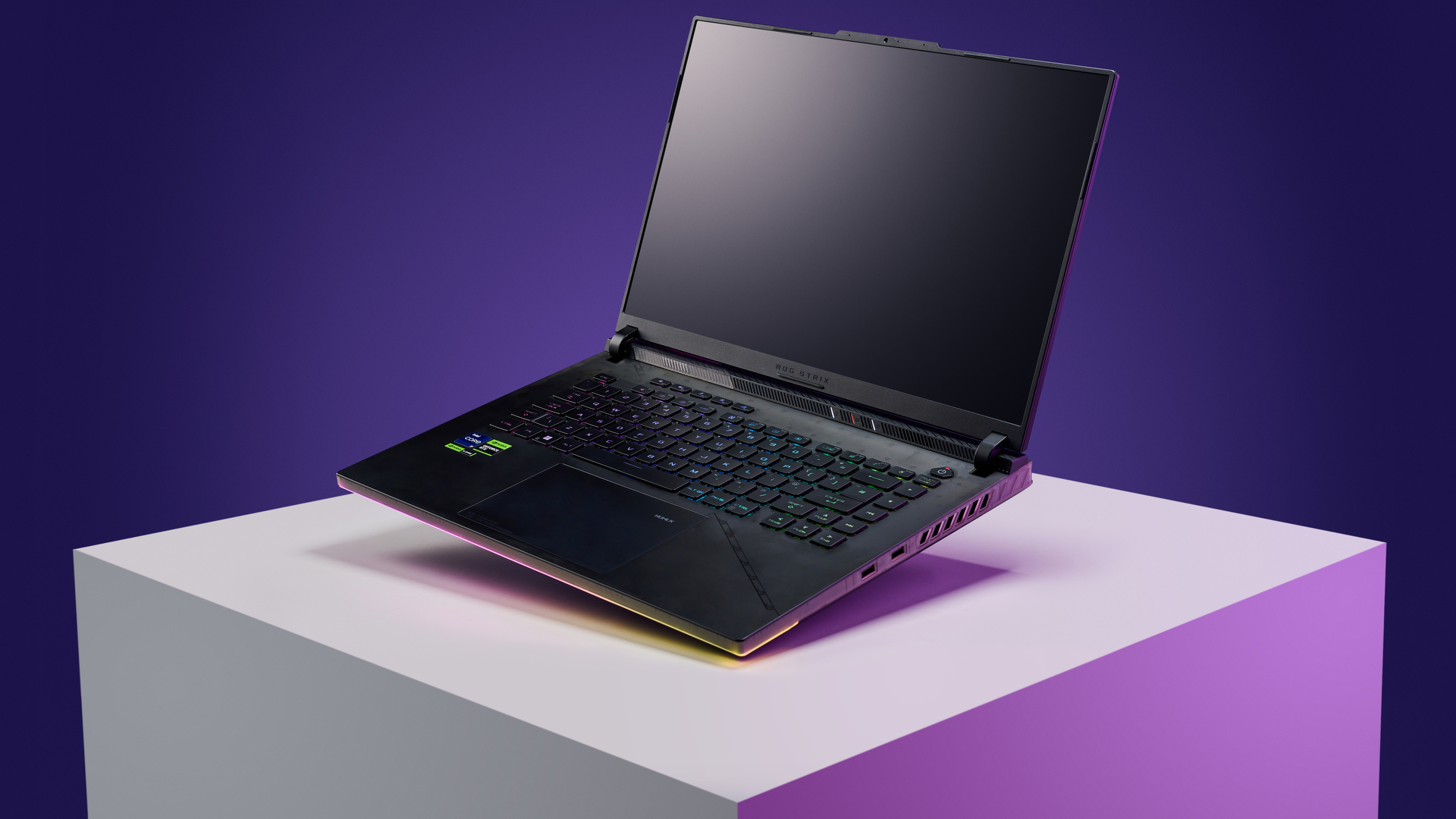Our Verdict
The ROG Strix Scar 16 (2023) model comes in hot, not just in terms of impressive gaming performance but inevitably temperature-wise, too. While it sometimes matches the more expensive gaming laptops in this year's lineup, the rest of the spec lets it down.
For
- Funky design
- Great gaming and encoding performance
- Surprisingly good battery life
- Lovely screen
Against
- Runs kinda hot
- SSD performance doesn't match the rest
- Better balanced machines can be had for less
- Optimus makes switching programs painful
- Camera is super oversaturated
PC Gamer's got your back
I've been testing the Asus ROG Strix Scar 16's 2023 G634 model. Available in the UK for £3,400, and with essentially the same model in the US priced at $2,750, there's an expectation of zero compromises for a gaming laptop containing both Intel and Nvidia's latest mobile offerings. Not just when it comes to gaming prowess, but the overall user experience. And while the RTX 4080 and Core i9 13980HX provide a fantastic core config for a gaming laptop today, there are a couple of things holding this powerful machine back, not least the competition at that price point.
Before we get into the numbers, the Scar 16 is off to a good start with its aesthetic. There's an industrial flair to the design, but not enough to make it look too 'edgy'. It's reminiscent of the resurgent retro console trend, with a subtle translucent plastic strip around the chassis edge and front.
It may not have the humble charm of a Clear Glacier Gameboy Advance, but at least the subtle RGB strip along the front and back edge doesn't undermine the aesthetic. The light gradates gently through the laptop's thickness and gives a gentle glow to the desk around it. The default rainbow ROG logo on the back is a little much for me, but that can be easily remedied in the Aura software.
It's been fascinating to see laptop manufacturers packing 16-inch gaming laptops with this generation's powerful components. How's it all going to fit? I wondered. The answer: It's all about girth, baby.
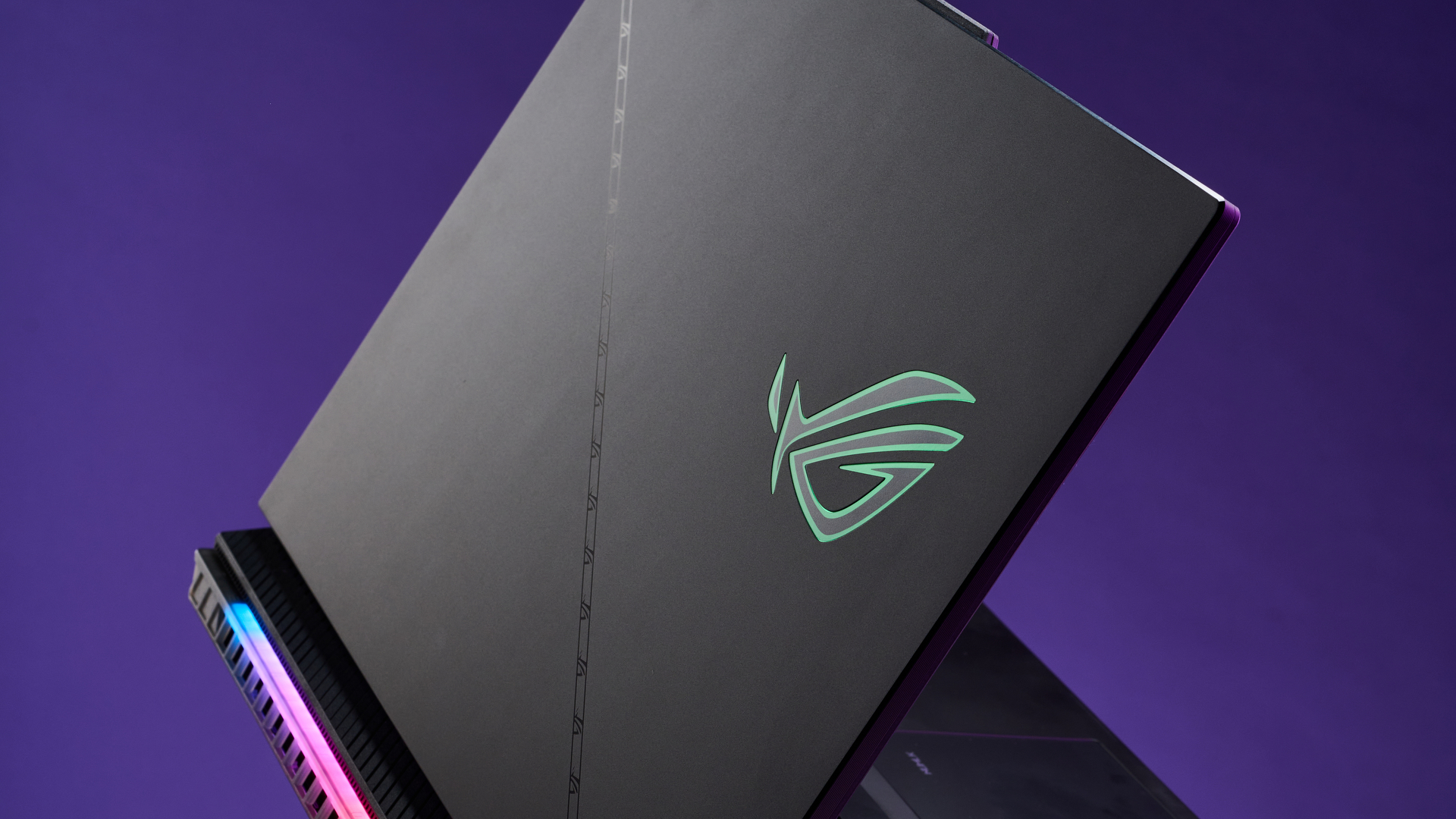
CPU: Intel Core i9 13980HX
Graphics: RTX 4080 (175W)
RAM: 16GB DDR5-4800
Display: 16-inch ROG Nebula HDR, 240Hz, 3ms
Storage: 1TB NVMe SSD
Ports/Connectivity: 1x 3.5mm Combo Audio Jack
1x HDMI 2.1 FRL, 1x USB 3.2 Gen 2 Type-C for display / power delivery, 2x USB 3.2 Gen 2 Type-A, 1x 2.5G LAN port, 1x Thunderbolt 4 DisplayPort with G-SYNC
Weight: 2.50kg / 5.51lbs
Size: 13.94 x 10.39 x 1.20 inches /35.4 x 26.4 x 3.04 cm
MSRP: £3,300 | $2,900
The Scar 16 is thick, and heavy enough to make me question the notebook nomenclature, though it's nowhere near as dense as the desktop replacements of yesteryear (see the 8lbs Gigabyte Aorus 17X YD). Still, the Scar is thick enough that I almost expected to find a mechanical keyboard under the lid.
No such luck, sadly, though the chiclet board has a pleasantly tactile bounce, and n-key rollover for gaming as one would expect. It's not the most satisfying to type on, but it does the job when it comes to gaming.
Along the thick edges you're looking at a couple of USB 3.2 Gen 2 Type-A ports on one side, and a pair of USB Type-C ports on the other—one Thunderbolt 4 with DisplayPort, the other for display and/or power delivery to peripherals. There is an HDMI 2.1 port as well as 2.5G ethernet port. In other words, high spec connectivity isn't going to be a problem, though some may be disappointed at the lack of non-USB Type-C DisplayPort.

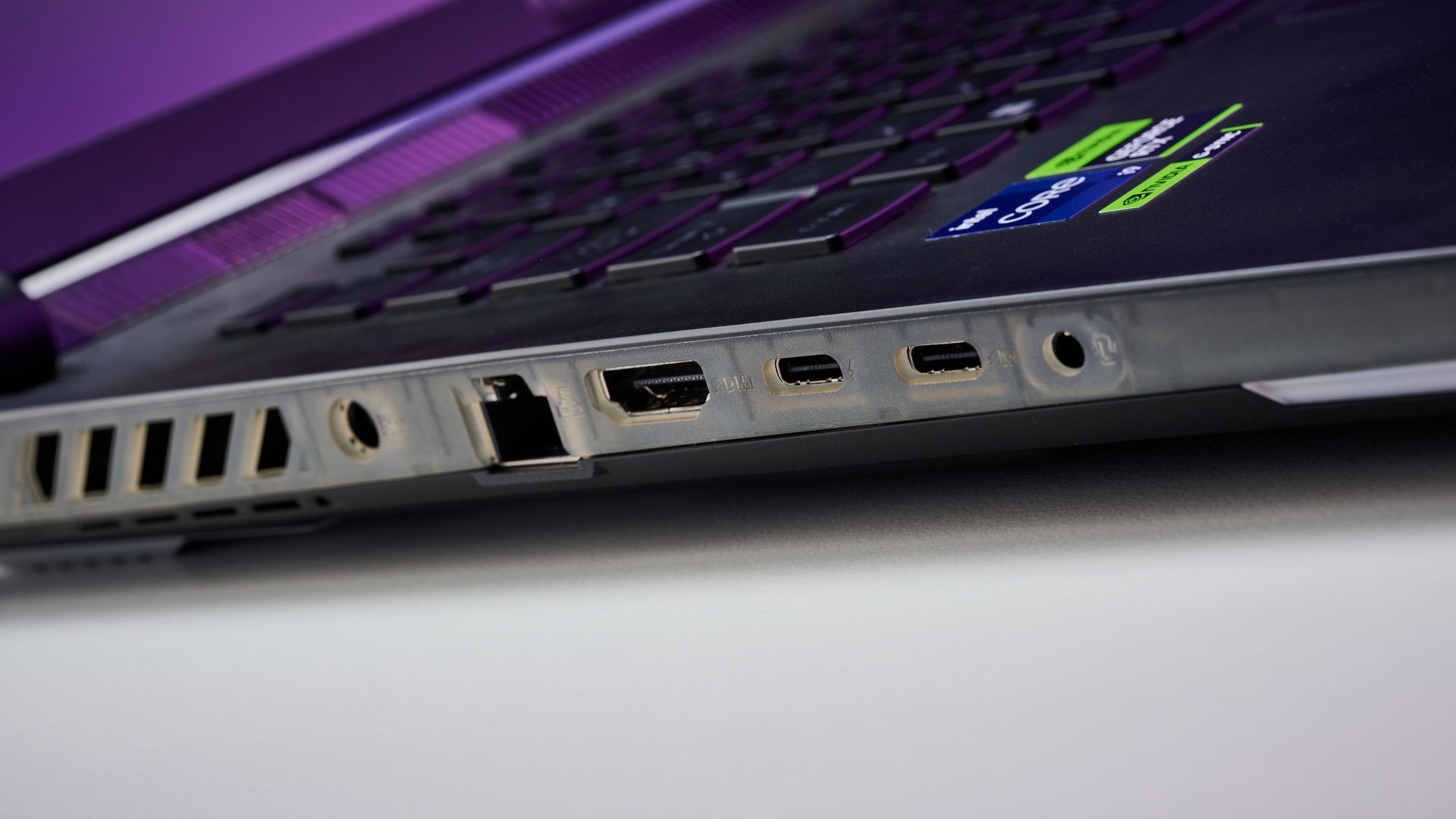
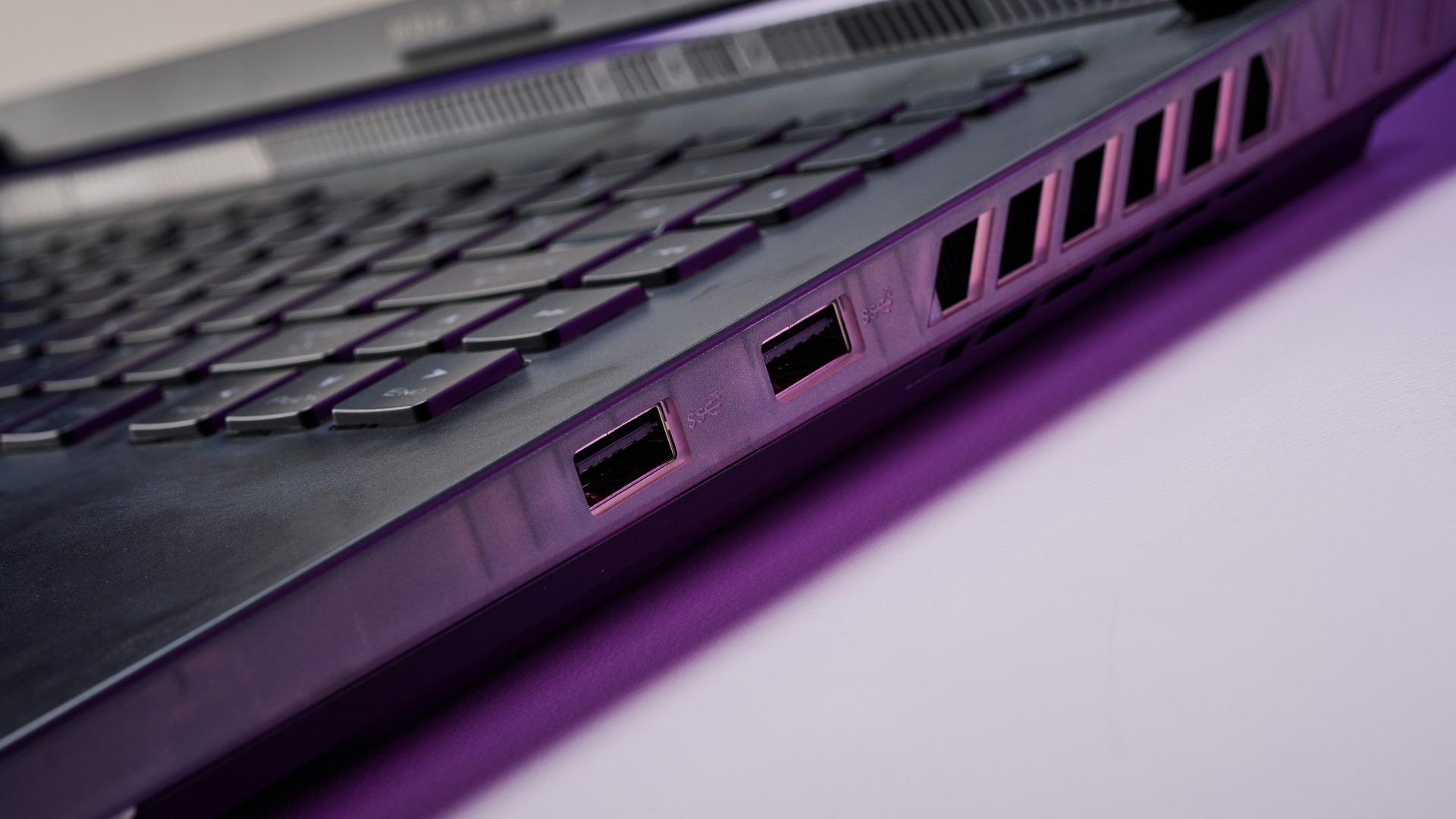
With the Asus ROG Strix Scar 16 packing a 175W RTX 4080 GPU under the hood, I noticed a few of the gaming performance numbers come close to, even blow straight past, some of other current-gen laptops we tested, even ones packing the RTX 4090 in its 150W form. In Cyberpunk 2077 for example, the Scar 16 manages 57 fps averages at 1080p against the Asus Zephyrus M16's 60 fps even in Ultra Ray Tracing mode.
Pitting it against that same 150W GPU at 1080p in Hitman 3's Dubai benchmark, the Scar 16 actually surpasses the RTX 4090's 240 fps average by a whopping 26 fps, albeit with a lower minimum framerate. That points to a little inconsistency, but a lot of potential.
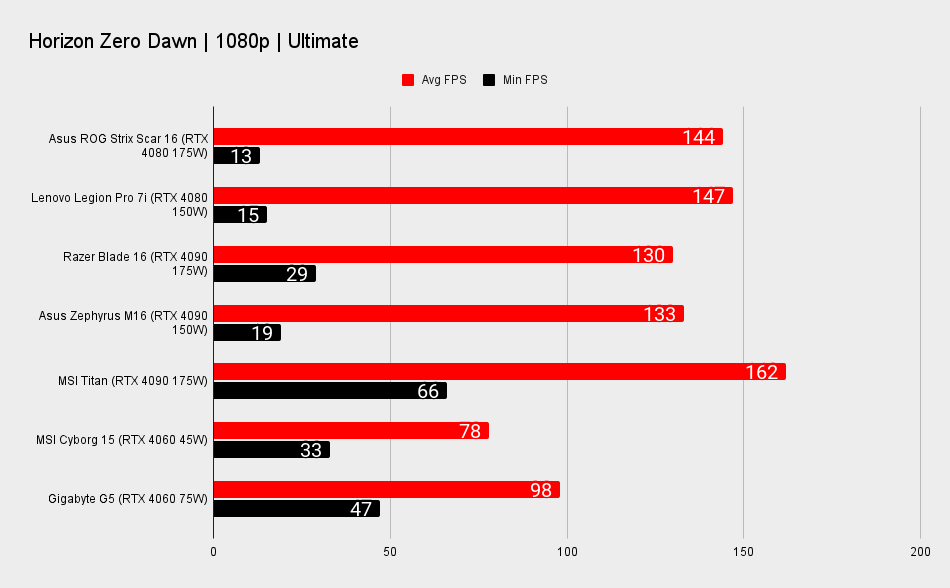
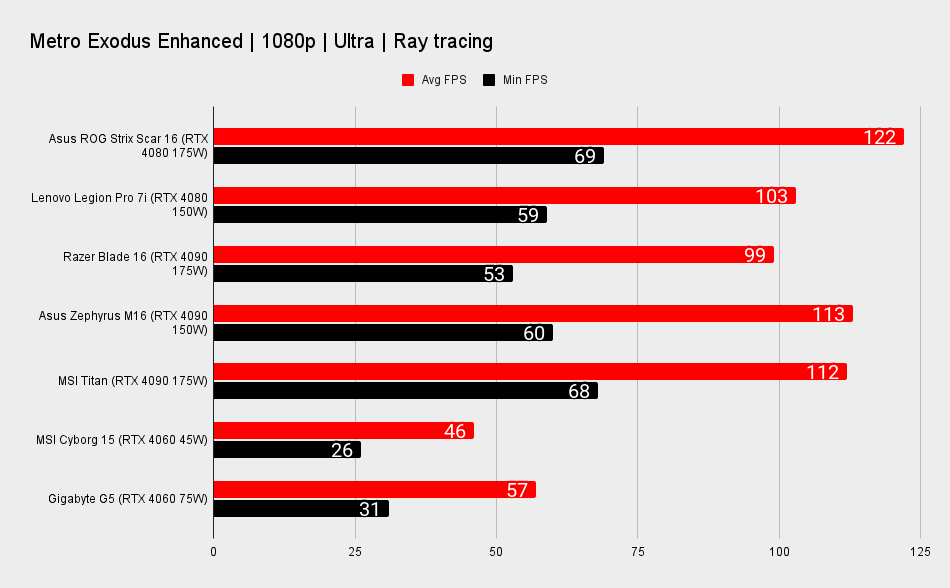
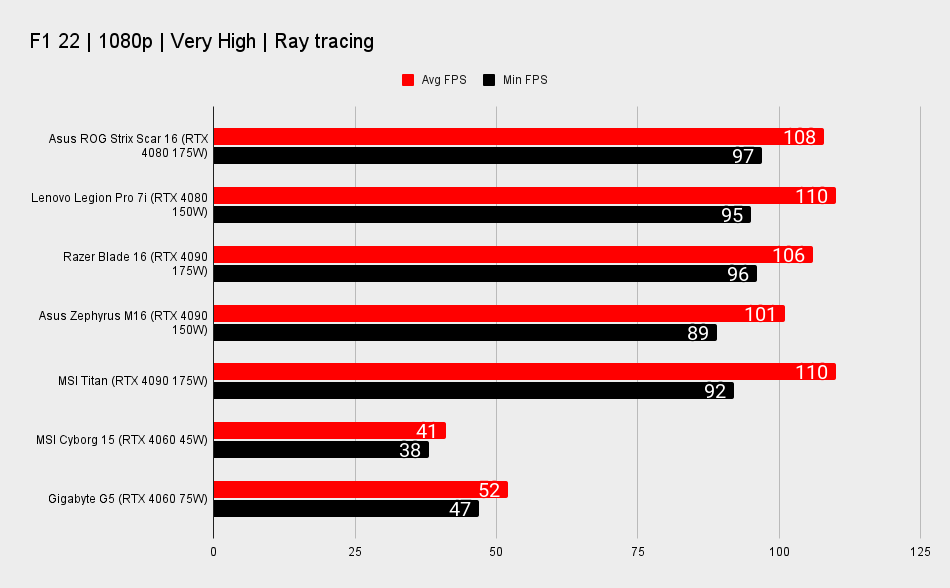
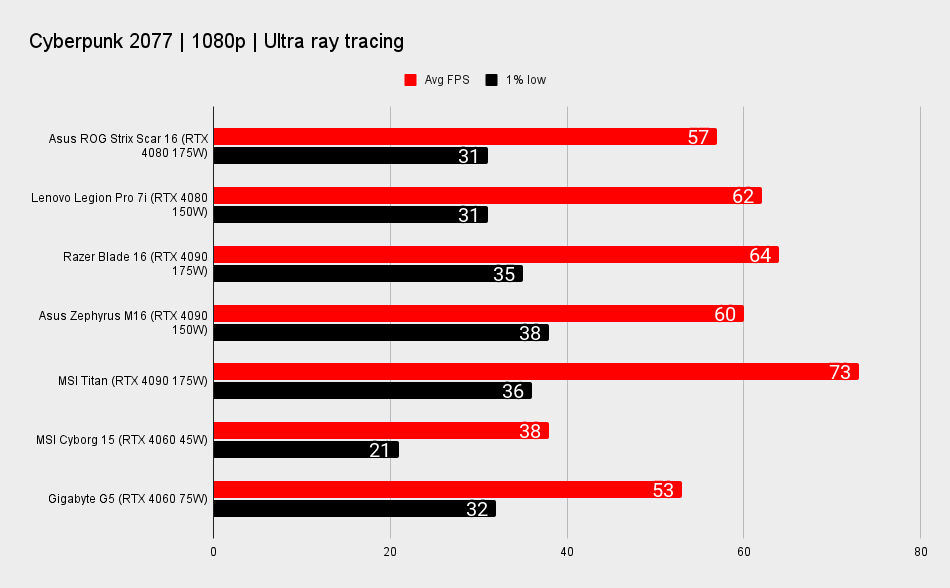
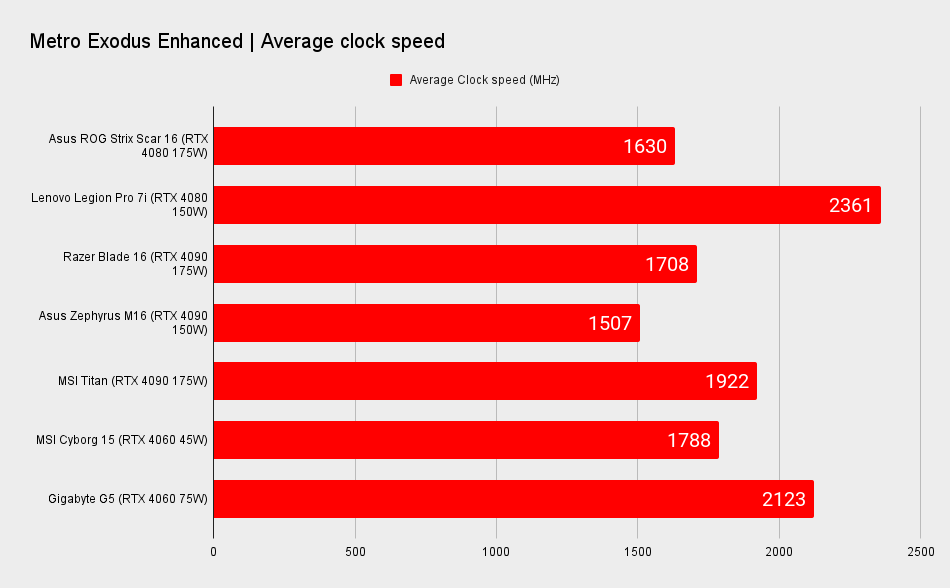
Context is key at higher resolutions—though the Lenovo Legion Pro 7i's panel is 1600p native, it was actually tested at 1440p. That means while it looks like the Scar is falling behind the less expensive machine and its 150W RTX 4080 in a few benchmarks, the Scar 16 was tested at its native 1600p—meaning there's actually not a lot in it.
While we're on the subject of the screen, that 16:10 Nebula screen is a nice ratio when you switch things up for a work session, though movies and cutscenes in games may end up sandwiched between black bars, as they tend to be designed with the standard 16:9 ratio in mind.
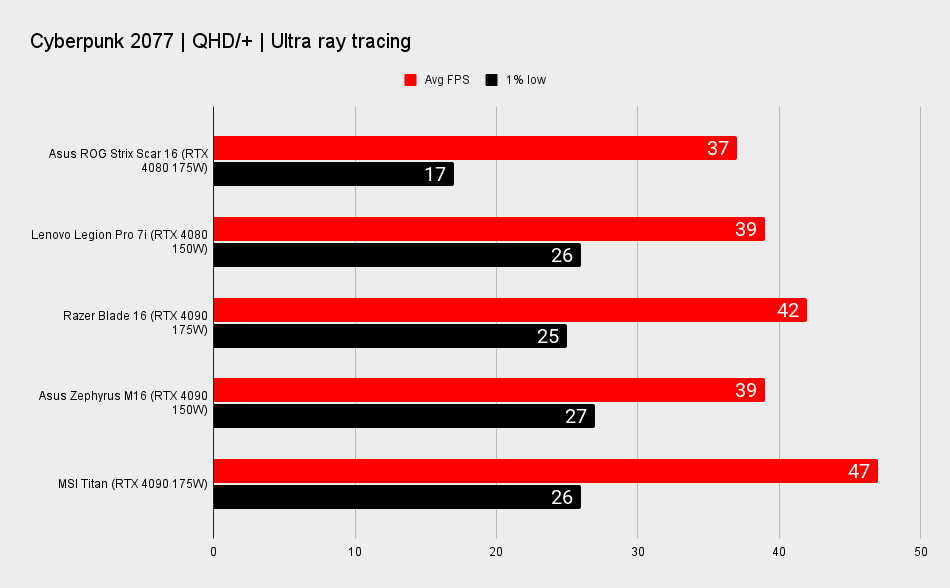

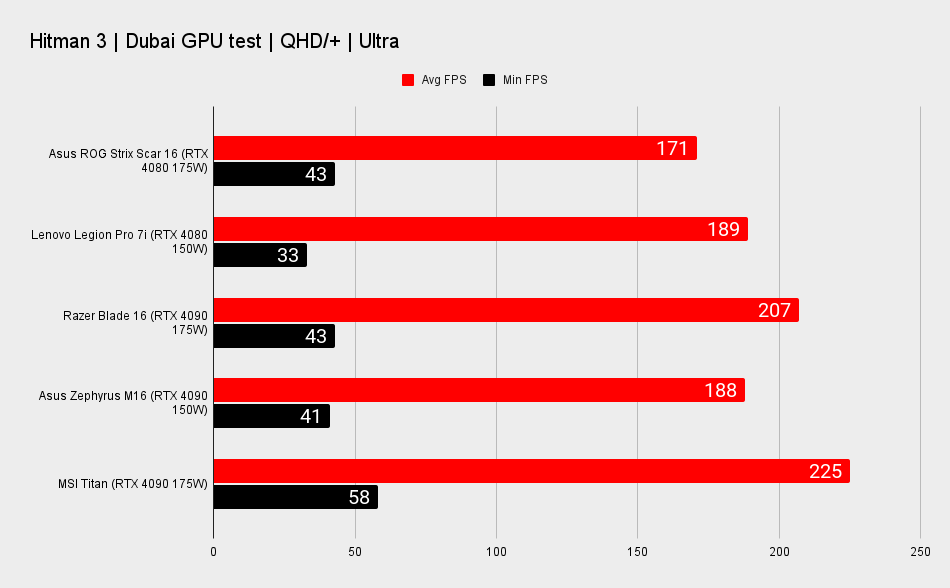

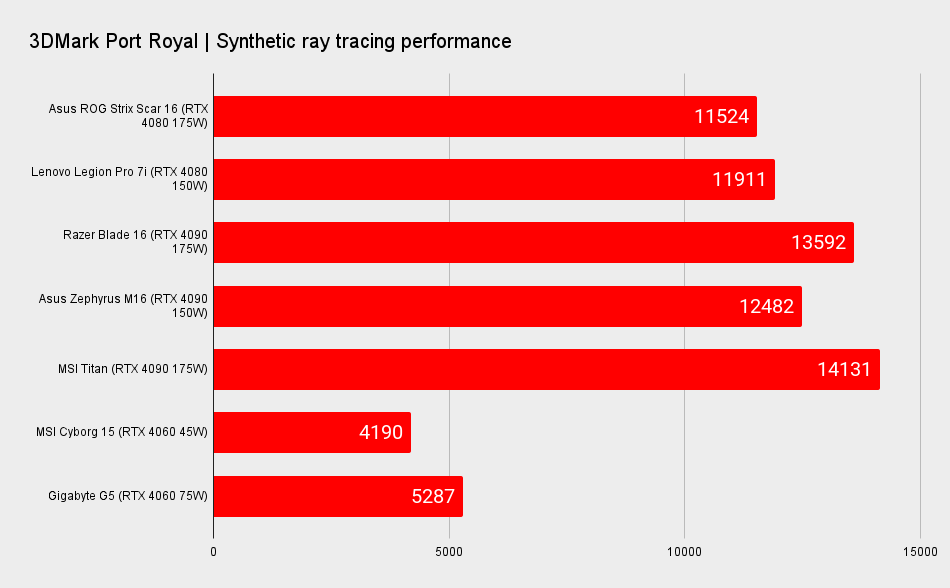
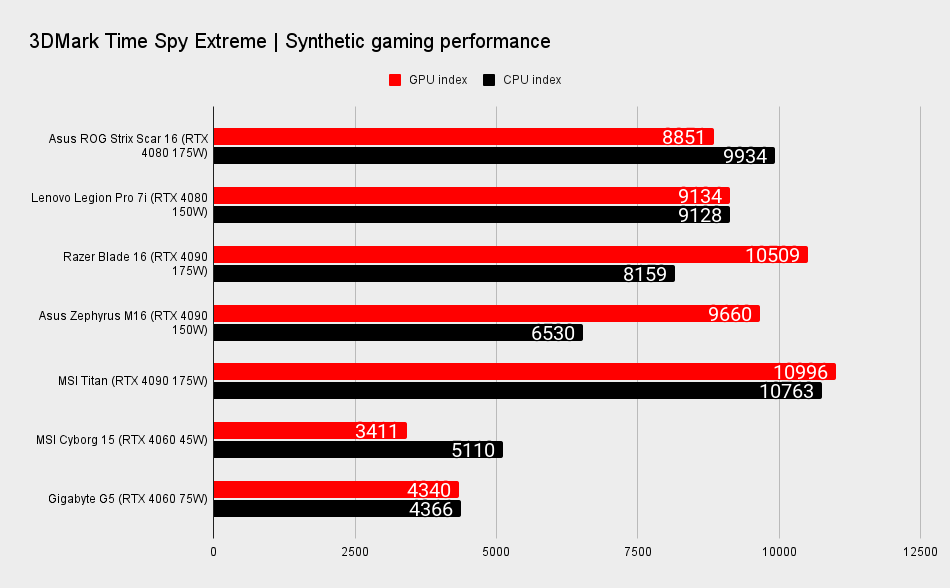
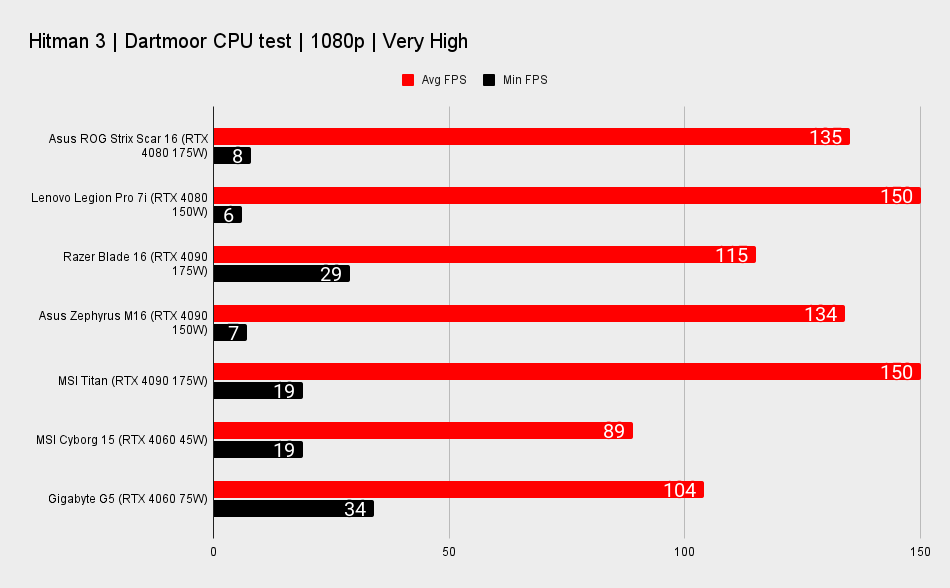
Still, it adds to the retro feel, like you're gaming on a CRT TV. Not that the tech behind the Nebula is even vaguely comparable to those old, flickering beasts.
This Mini-LED panel handles HDR well—though this generally isn't the case for desktop monitors, the smaller panels on laptops mean smaller dimming zones, and in turn the usual issues become less visible. This panel came out looking velvety and rich with no calibration necessary. A cherry atop a fine gaming laptop, indeed. And with the kind of power this thing is packing, the monster 240Hz refresh rate leaves little legroom for some games, even in Ultra settings at its native 1660p resolution.

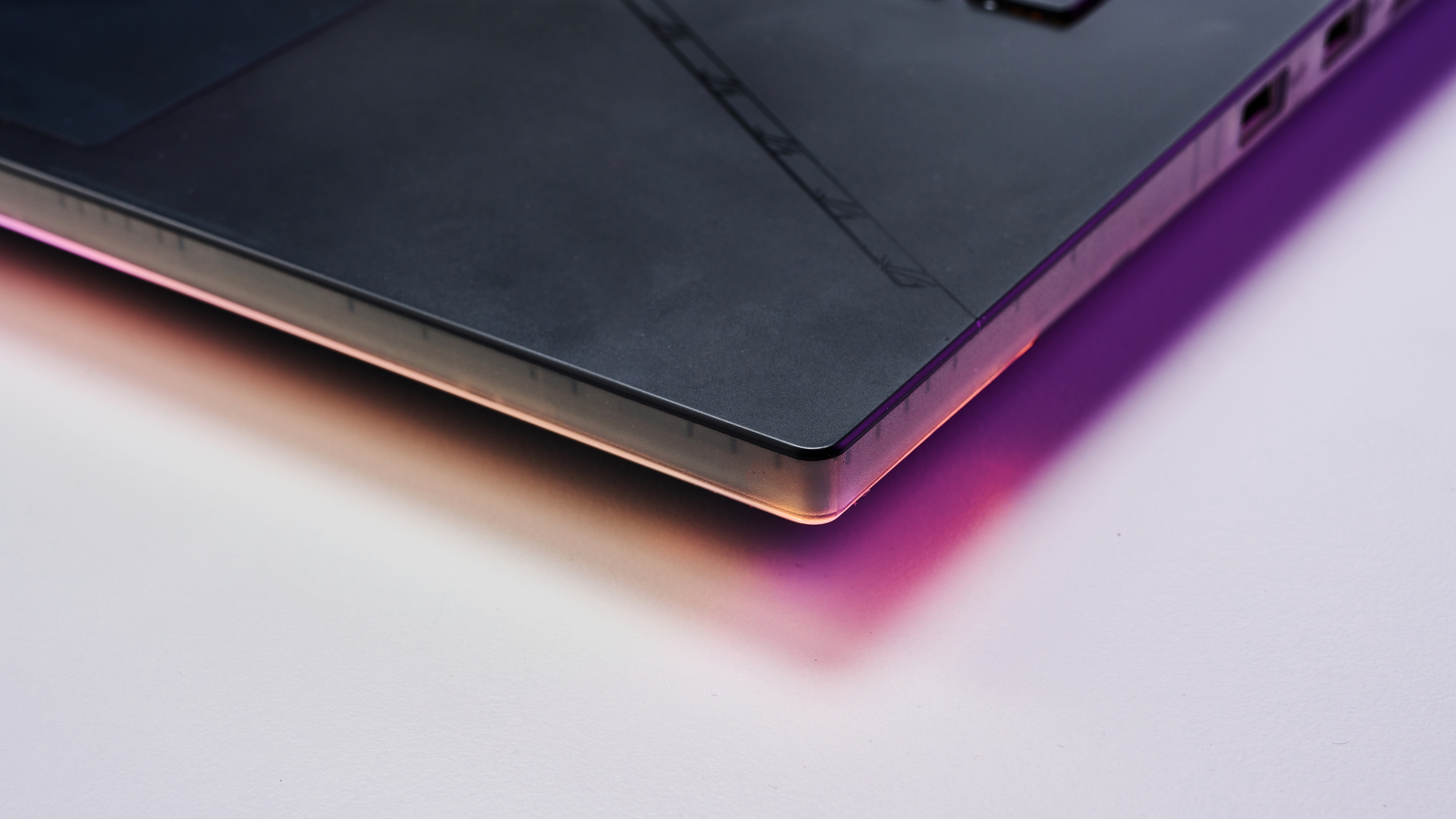
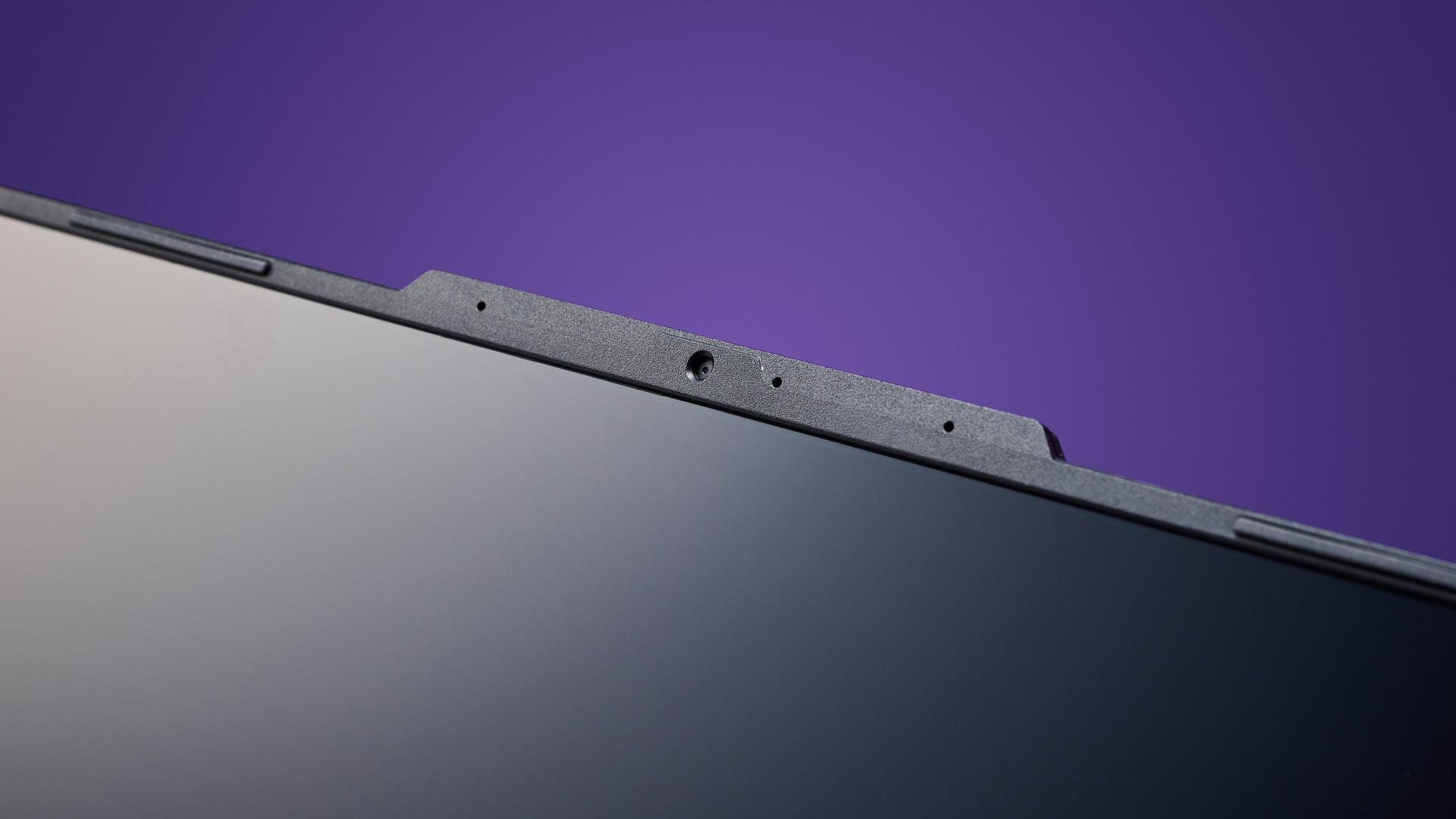
If you've not got yourself one of the best gaming headsets, you could do worse than the Scar 16's speakers, too. They're a little muddy from being packed into suck a tight chassis, though generally they're rich and bass-friendly. The 720p webcam handles low light well and sits in the right place, but it does give me lobster-red flush.
The real star of the show is the Intel Core i9 13980HX. A CPU like this gives the Strix Scar 16 a leg up against some of the $4,000 laptops of this generation. Sure you're missing out on some of the GPU power, but the Scar doesn't mess around when it comes to handling all those physics simulations in the ever destructible environments we're seeing in games today.
The Minimum CPU samples per minute in Blender's Junkyard benchmark shows it's got a lot to offer game artists, too.
It puts even the $4,000 Zephyrus M16's i9 13900H to shame when it comes to video encoding, and although its multi-core performance falls behind the $5,300 MSI Titan's i9 13950HX in rendering benchmarks, it's single-core you're looking at for gaming. There the Strix Scar stands with the best. You might think that slight multithreading miss translates badly in Blender, but the Minimum CPU samples per minute in Blender's Junkyard benchmark shows it's got a lot to offer game artists, too.
All that power in hungriness comes at a price, however and it means that while the Strix Scar 16's hour and twenty minute battery life sits in the middle compared to other gaming laptops of it's class, it's still not at the level we want from a portable device. It also runs a little hot for my liking. The CPU and GPU hit 105°C and 83°C respectively under load, which is hotter than the rest we tested.
There's some serious coil whine coming from under the hood when you boot up a game, too. It's drowned out by the laptop's fans mostly, but it can sound quite concerning if you're not used to these kinds of common hardware noises.
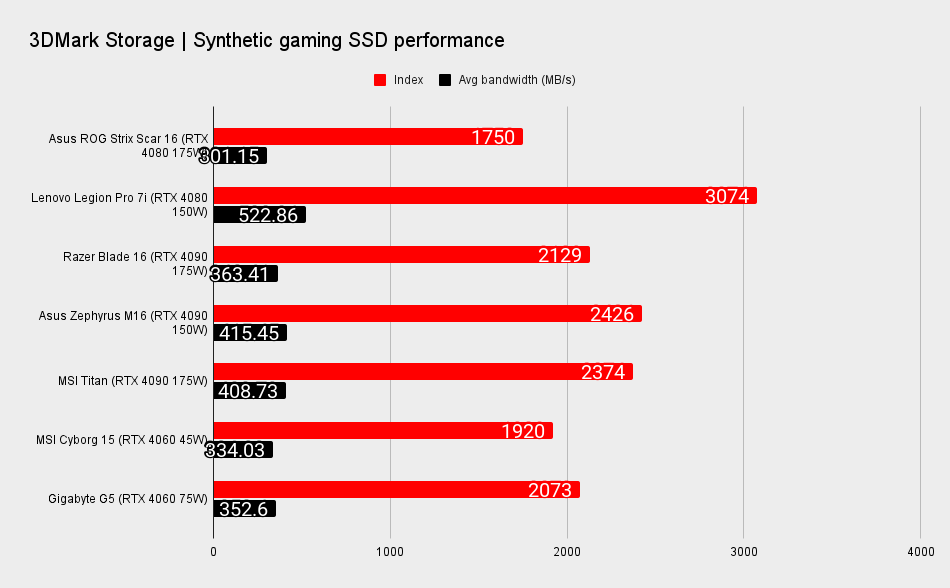
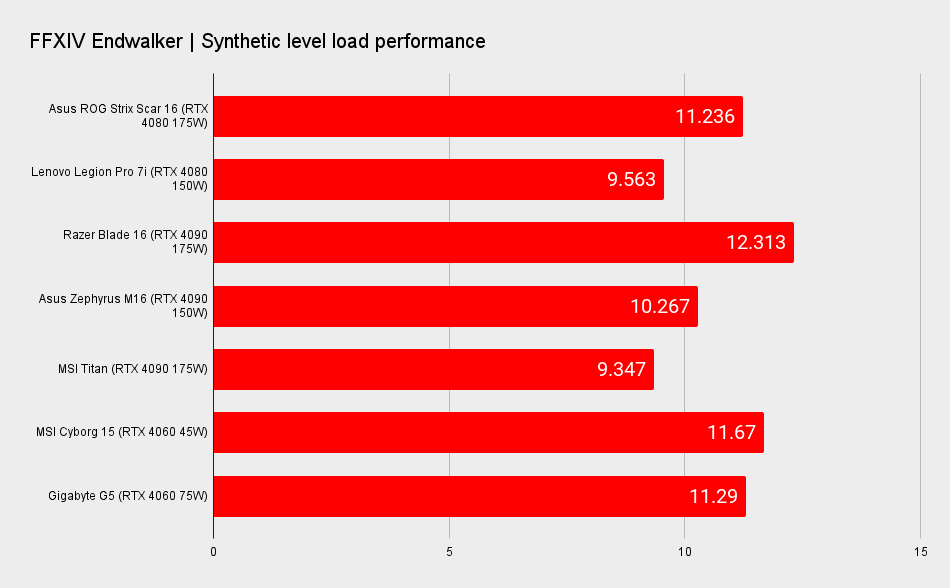
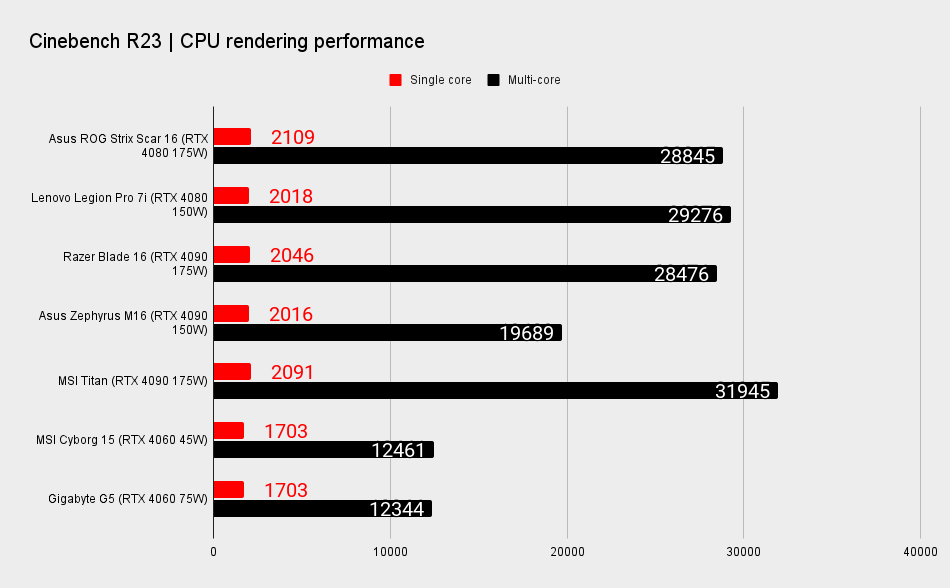
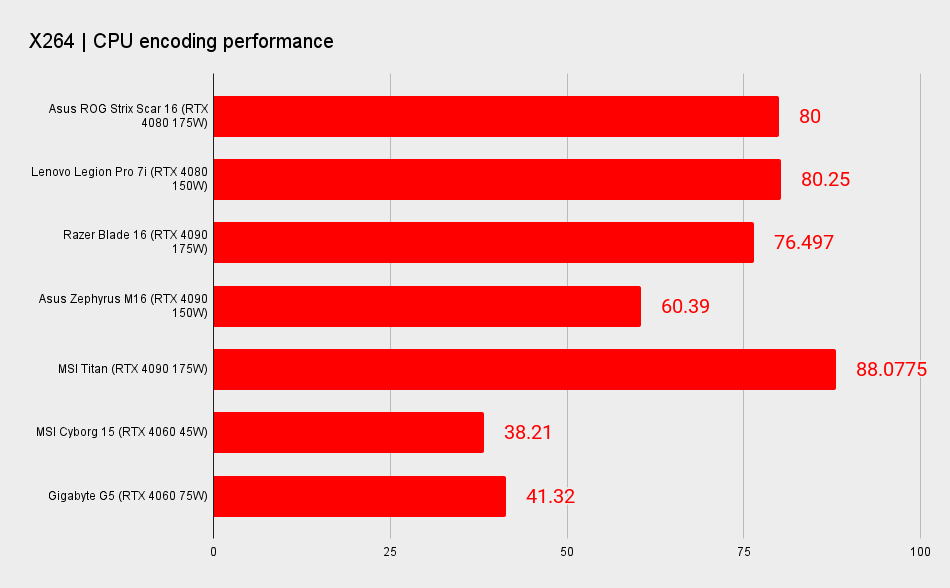
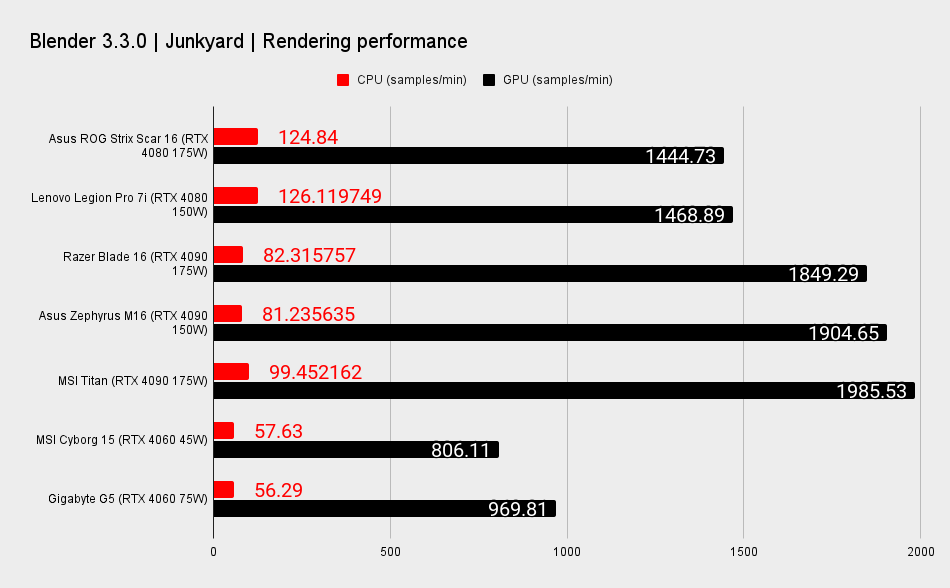

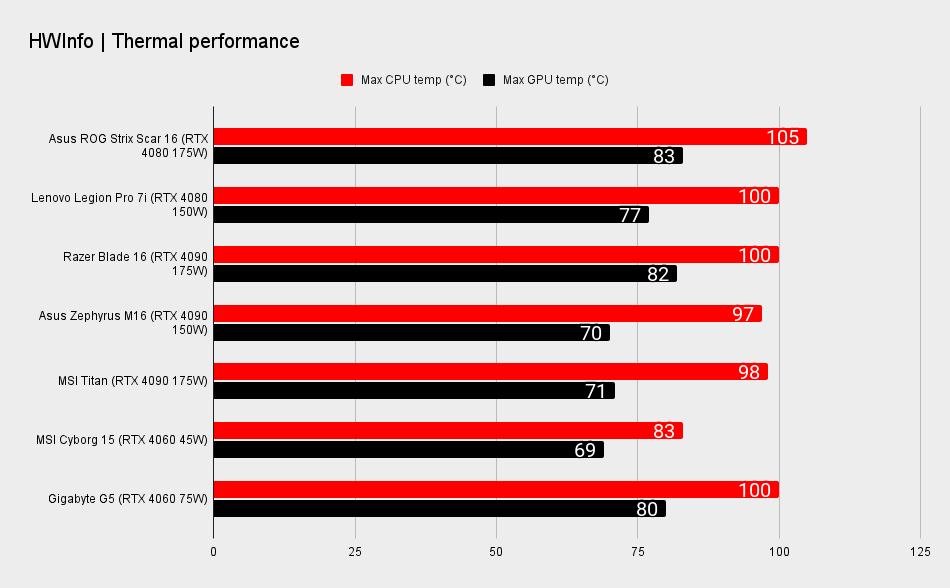
As for general use, I've come up against a few issues with the Nvidia Optimus tech. While it's likely contributing to a slightly more impressive battery life, this data-rerouting middleman can create a bottleneck when it comes to gaming, and makes switching between programs a less than seamless experience. The Scar has also been a little unresponsive in general when opening some programs, and crashed just from trying to open PCMark 10 at one point—with no other programs open, aside from Steam running in the background. And even though the Scar's positioned itself nicely as a 3D rendering and video encoding machine, the 16GB of dual-channel DDR5-4800 RAM means it may still struggle against some modern use cases.
The Strix Scar's SSD also lags behind the competition, with the 3DMark storage index score sitting disappointingly lower than the less expensive Legion Pro 7i. Pair the 103ns against the Legion's speedy 58ns, and FFXIV Endwalker load times of 11.236 seconds against a tasty 9 seconds, and it's clear there's a lot to be desired in the storage department.
Sadly, despite the Asus ROG Strix Scar 16 really packing a punch with the core spec, the surrounding components let it down. At £3,300 / $2,900 it's worth considering the Lenovo Legion Pro 7i as an alternative for $150 less. That way you get a similarly powerful gaming laptop, but one that's better balanced overall, and even comes with 32GB of DDR5-6000 memory compared to the Scar 16's 16GB. It's an even better compromise in the UK for £600 less, and although the battery life is a little less impressive we're sort of resigned to keeping gaming laptops chained to the wall socket, at this point.
The ROG Strix Scar 16 (2023) model comes in hot, not just in terms of impressive gaming performance but inevitably temperature-wise, too. While it sometimes matches the more expensive gaming laptops in this year's lineup, the rest of the spec lets it down.

Screw sports, Katie would rather watch Intel, AMD and Nvidia go at it. Having been obsessed with computers and graphics for three long decades, she took Game Art and Design up to Masters level at uni, and has been rambling about games, tech and science—rather sarcastically—for four years since. She can be found admiring technological advancements, scrambling for scintillating Raspberry Pi projects, preaching cybersecurity awareness, sighing over semiconductors, and gawping at the latest GPU upgrades. Right now she's waiting patiently for her chance to upload her consciousness into the cloud.
